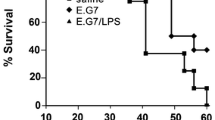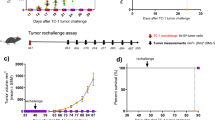Abstract
Polysaccharide K (PSK) is a biological response modifier used for adjuvant immunotherapy of malignant diseases. We studied the potential applicability of PSK for preventing tumor progression using an experimental model of murine lymphoma. Mice inoculated with the radiation leukemia virus (RadLV) develop thymic lymphomas after a latency of 3–6 months. However, 2 weeks after virus inoculation, prelymphoma cells can already be detected in the thymus. We found that PSK treatment induced hyperresponsiveness to concanavalin A and heightened production of interleukin-2 (IL-2) and IL-4 in spleen cells of both control and prelymphoma mice. The response was transient and was accompanied with a dominant usage of T cells expressing Vβ8, but other T cell subsets were also stimulated by PSK. T lymphoma cells expressing Vβ8.2 underwent apoptosis when incubated with PSK. Treatment of RadLV-inoculated mice with PSK delayed the onset of overt lymphoma (and mortality) but could not protect the mice from the disease. Combined treatment with PSK and a RadLV-specific immunotoxin prevented synergistically the progression of the prelymphoma cells to frank lymphoma. The results suggest that PSK contains a superantigen-like component that selectively activates Vβ8+ T cells. Its administration prelymphoma mice interfered with the process of lymphoma progression.
Similar content being viewed by others
References
Tsukagoshi S, Hashimoto Y, Fujii G, Kobayashi H, Nomoto K, Orita K (1984) Krestin (PSK). Cancer Treat Rev 11: 131
Ebihara K, Minamishima Y (1984) Protective effect of biological response modifiers on murine cytomegalovirus infection. J Virol 51: 117
Enrke MJ, Reino JM, Eppolito C, Mihich E (1983) The effect of PSK, a protein bound polysaccharide on immune responses against allogeneic antigens. Int J Immunopharmacol 5: 35
Hosokawa M, Mizukoshi T, Sugawara M, Kobayashi H (1985) Therapeutic effects of PSK and busulfan on the recurrent and metastatic diseases after the surgical removal of 3-methylcholanthrene-induced autochtonous tumors in C57BL/6 mice. Gann 76: 61
Kondo M, Kato H, Yokoe N, Matsumura N, Hotta T, Masasuke M (1978) Activation of the complement by immunostimulants, BCG, OK-432 (Picibani), and PS-K (Krestin) in vitro. Gann 69: 699
Mizushima Y, Yuhki N, Hosokawa M, Kobayashi H (1982) Diminution of cyclophosphamide-induced suppression of antitumor immunity by an immunomodulator PSK and combined therapeutic effects of PSK and cyclophosphamide on transplanted tumor in rats. Cancer Res 42: 5176
Nomoto K, Yoshikumi C, Matsunaga K, Fujii T, Takeya K (1975) Restoration of antibody-forming capacities by PS-K in tumorbearing mice. Gann 66: 365
Tsurku S, Nomoto K (1983) Effects of PSK on specific tumor immunity to syngeneic tumor cells. J Clin Lab Immunol 4: 215
Torisu M, Hayashi Y, Ishimitsu T, Fujimura T, Iwasaki K, Katano M, Yamamoto H, Kimura Y, Takesue M, Motoharu K, Nomoto K (1990) Significant prolongation of disease-free period gained by oral polysaccharide K (PSK) administration after curative surgical operation of colorectal cancer. Cancer Immunol Immunother 31: 261
Nakazato H, Koike A, Saji S, Ogawa N, Sakamoto J (1994) Efficacy of immunochemotherapy as adjuvant treatment after curative resection of gastric cancer. Lancet 343: 1122
Mitomi T (1992) Randomized, controlled study on adjuvant immunochemotherapy with PSK in curatively resected colorectal cancer. Dis Colon Rectum 35: 123
Fujii T, Saito K, Oguchi Y, Matsunaga K, Kobayashi Y, Yoshikumi C, Taguchi T (1988) Effects of the protein-bound polysacharide preparation, PSK on spontaneous breast cancer in mice. J Int Med Res 16: 286
Yamane T, Fujita Y, Sagara Y, Okuzumi J, Kuwata K, Tanaka M, Takahashi T (1989) The effect of a protein-bound polysaccharide preparation, PS-K, on carcinogenesis in the glandular stomach of rats induced byN-methyl-N'-nitro-N-nitrosoguanidine. J Kyoto Prefect Univ Med 98: 307
Nakajima T, Ichikawa S, Uchida S, Komada T (1990) Effects of a protein-bound polysaccharide from a basidiomycetes against hepatocarcinogenesis induced by ′3-methyl-4-dimethylaminoazobenzene in rats. Clin Ther 12: 385
Henderson BE, Ross RK, Pike MC (1991) Towards the primary prevention of cancer. Science 254: 1131
Baum M, Ziv Y, Colletta AA (1991) Can we prevent breast cancer? Br J Cancer 66: 205
Klein G, Klein E (1985) Evolution of tumors and the impact of molecular oncology. Nature 315: 190
Weinberg RA (1989) Oncogenes, antioncogenes, and the molecular bases of multistep carcinogenesis. Cancer Res 49: 3713
Vogelstein B, Kinzler KW (1993) The multistep nature of cancer. Trends Genet 9: 138
Wakefield LA, Sporn MB (1990) Suppression of carcinogenesis: a role for TGF-β and related molecules in prevention of cancer. In: Klein G (ed) Tumor suppressor genes. Dekker, New York, p 217
Haran-Ghera N (1978) Spontaneous and induced preleukemia cells in C57BL/6 mice. J Natl Cancer Inst 60: 707
Haran-Ghera N, Peled A (1979) Induction of leukemia in mice by irradiation and radiation leukemia virus variants. Adv Cancer Res 30: 45
Ben-David Y, Kotler M, Yefenof E (1987) Leukemogenic, immunogenic and genetic properties of a thymotropic radiation leukemia virus. Int J Cancer 39: 492
Ben-David Y, Yefenof E, Kotler M (1987) Clonal analysis of radiation leukemia virus (RadLV) induced leukemic and preleukemic cells. Cancer Res 47: 6590
Yefenof E, Epsztein S, Kotler M (1991) Quantitation, in vitro propagation and characterization of preleukemic cells induced by radiation leukemia virus. Cancer Res 51: 2179
Yefenof E, Ela C, Kotler M, Vitetta ES (1992) Induction of IL-4 secretion by the radiation leukemia virus (RadLV): role in autocrine growth stimulation of RadLV infected pre-leukemic cells. Int J Cancer 50: 481
Yefenof E, Abboud G, Epsztein S, Vitetta ES (1992) Treatment of premalignancy: prevention of lymphoma in radiation leukemia virus inoculated mice by cyclosporin A and immunotoxin. Proc Natl Acad Sci USA 89: 728
Haas M (1974) Continuous production of radiation leukemia virus in C57BL thymona tissue culture lines: purification of the leukemogenic virus. Cell 1: 79
Haran-Ghera N, Ben-Yaakov M, Peled A (1977) Immunologic characteristics in relation to high and low leukemogenic activity of radiation leukemia virus variants. J Immunol 118: 600
Yefenof E, Meidav A, Kedar E (1980) In vitro generation of cytotoxic lymphocytes against radiation and radiation leukemia virus (RadLV) induced tumors: III. Suppression of anti-tumor immunity in vitro by lymphocytes of mice undergoing RadLV induced leukemogenesis. J Exp Med 152: 1473
Fulton RJ, Uhr JW, Vitetta ES (1988) In vitro therapy of the BCL1 tumor: Effect of immunotoxin valency and deglycosylation of the ricin A chain. Cancer Res 48: 2626
Pullen AM, Marrack P, Kappler JW (1988) The T cell repertoire is heavily influenced by tolerance to polymorphic self antigens. Nature 335: 796
Tomonari K, Lovering E, Spencer S (1990) Correlation between the Vβ4+CD8+ T cell population and the H-2d haplotype. Immunogenetics 31: 333
MacDonald HR, Schneider R, Less RK, Howe RC, Acha-Orbea H, Festenstein H, Zinkernagel RM, Hengartner H (1988) T-cell receptor Vβ use predicts reactivity and tolerance to Mlsa-encoded antigens. Nature 332: 40
Staerz U, Rammensee H, Benedetto J, Bevan M (1985) Characterization of a murine monoclonal antibody specific for an allotypic determinant on T cell antigen receptor. J Immunol 134: 3994
Haskins K, Hannum C, White J, Roehm N, Kubo R, Kappler J, Marrack P (1984) The antigen specific, major histocompatibility complex-restricted receptor on T cells. VI. An antibody to a receptor allotype. J Exp Med 160: 452
Kappler JW, Staerz U, White J, Marrack PC (1988) Self-tolerance eliminates T cells specific for M1s-modified products of the major histocompatibility complex. Nature 332: 35
Tomonari K, Lovering E (1988) T cell receptor specific monoclonal antibodies against a Vβ11 positive mouse T cell clones. Immunogenetics 28: 445
Kappler JW, Wade T, White J, Kushner E, Blackman M, Bill J, Roehm N, Marrack P (1987) A T cell receptor Vβ segment that imparts reactivity to a class II major histocompatibility complex product. Cell 49: 263
Wyllie AH (1980) Glucocorticoid-induced thymocyte apoptosis is associated with endogenous endonuclease activation. Nature 284: 555
Reference deleted
Fleischer B (1992) Superantigens. Curr Opin Immunol 4: 392
Yefenof E, Einat E, Klein E (1991) Potentiation of T cell immunity against radiation-leukemia-virus-induced lymphoma by polysaccharide K. Cancer Immunol Immunother 34: 133
Boccoli G, Masciulli R, Ruggeri EM, Carlini P, Giannella G, Mongtesoro E, Mastroberardino G, Isacchi G, Testa U, Calabresi F, Peschle C (1990) Adoptive immunotherapy of human cancer: the cytokine cascade and monocyte activation following high-dose Interleukin 2 Bolus treatment. Cancer Res 50: 5795
Dupere S, Obiri N, Lackey A, Emma D, Yannelli J, Orr D, Birch R, O'Conner TE (1990) Patterns of cytokines released by peripheral blood leukocytes of normal donors and cancer patients during interleukin-2 activation in vitro. J Biol Responses Mod 9: 140
Economou JS, Hoban M, Lee JD, Essner R, Swisher S, McBride W, Hoon DB, Morton DL (1991) Production of tumor necrosis factor α and interferon γ in interleukin-2-treated melanoma patients: correlation with clinical toxicity. Cancer Immunol Immunother 34: 49
Vetto JT, Papa MZ, Lotze MT, Chang AE, Rosenberg SA (1987) Reduction of toxicity of interleukin-2 and lymphokine-activated killer cells in humans by the administration of corticosteroids. J Clin Oncol 5: 496
Margolin KA, Rayner AA, Hawkins MJ, Atkins MB, Dutcher JP, Fisher RI, Weiss GR, Doroshow JH, Jaffe HS, Roper M, Parkinson DR, Wiernik PH, Creekmore SP, Boldt DH (1989) Interleukin-2 and lymphokine-activated killer cell therapy of solid tumors: analysis of toxicity and management guidelines. J Clin Oncol 7: 486
Bukowski RM, Murthy S, Sergi J, Budd GT, McKeever S, Medendorp SV, Tubbs R, Gibson V, Finke J (1990) Phase I trial of continuous infusion recombinant interleukin-2 and intermittent recombinant interferon-α2a: Clinical effects. J Biol Response Mod 9: 538
Author information
Authors and Affiliations
Rights and permissions
About this article
Cite this article
Yefenof, E., Gafanovitch, I., Oron, E. et al. Prophylactic intervention in radiation-leukemia-virus-induced murine lymphoma by the biological response modifier polysaccharide K. Cancer Immunol Immunother 41, 389–396 (1995). https://doi.org/10.1007/BF01526559
Received:
Accepted:
Issue Date:
DOI: https://doi.org/10.1007/BF01526559




